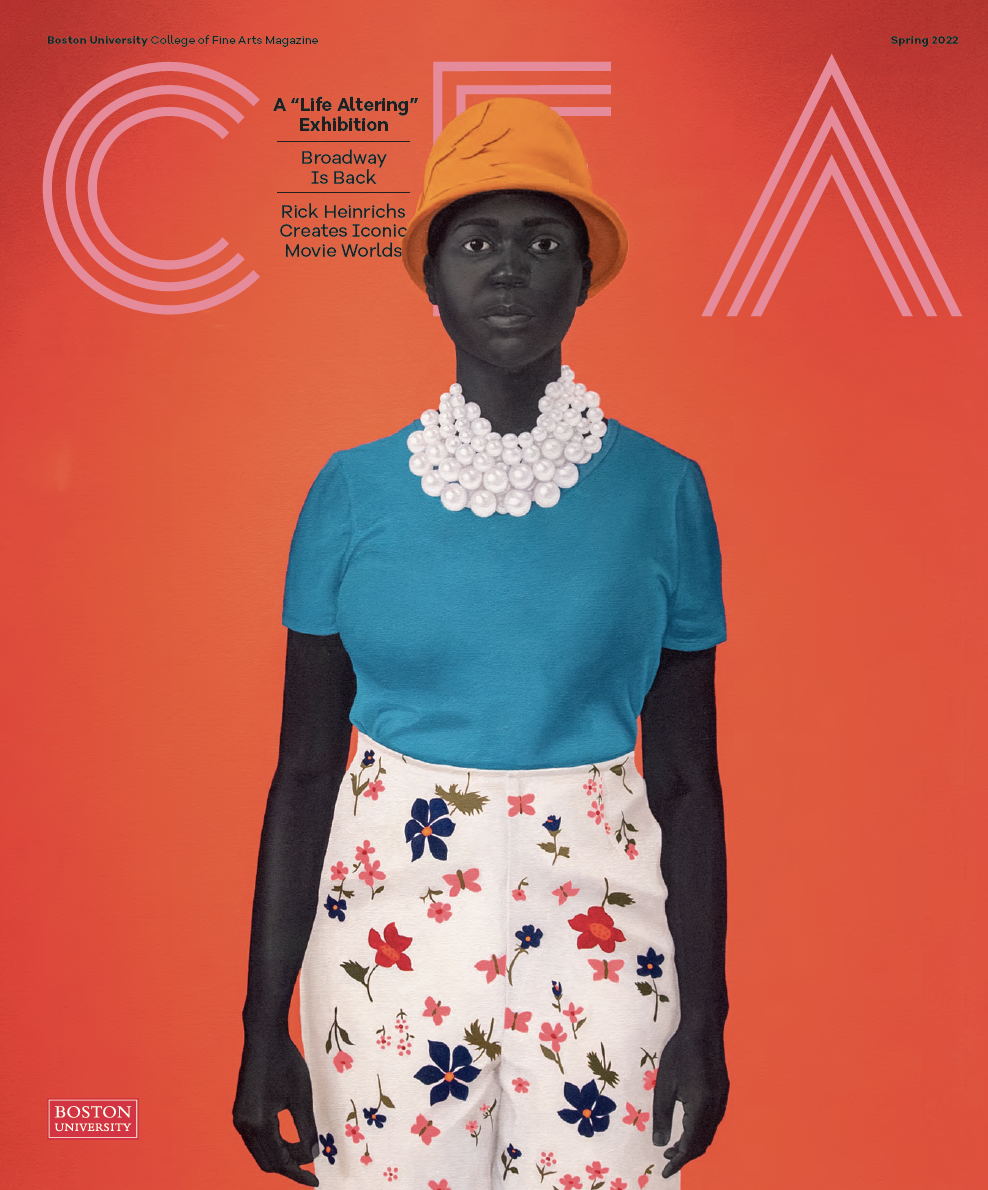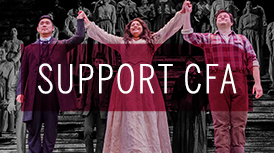Alternative Visions/Sustainable Futures Exhibition
Alternative Visions / Sustainable Futures exhibition and event series puts eco-awareness under an artistic lens.
By Jessica Ullian | Photo by Vernon Doucette
Conversation, action, debate—a frenzy of activity filled the 808 Gallery during the installation of the 12×16-foot inflatable shelter, Festooning. You might say the place was buzzing. After all, Festooning was a giant beehive designed to allow up to 20 people, or what the artists call “human beeings,” to become fully immersed in the apicultural experience.
“A festoon is a relationship between different entities, something that connects several distinct shapes,” says Maria Molteni (’06), cocreator of the installation, which is named for the word’s dual meanings: a decorative material that drapes between two points and the way bees hang together on a comb to produce wax. “It’s a way of working in which different beings come together to form one thing in a celebratory way.”
Festooning was just one of the installations featured in the System: ECOnomies exhibition, which opened on January 24, 2013, as part of the overarching Alternative Visions / Sustainable Futures exhibition and event series. The School of Visual Arts and Boston University’s Sustainability Program collaborated on the series to explore environmental sustainability through an artistic lens. Unfolding over the course of the 2013 Spring Semester, Alternative Visions / Sustainable Futures encompassed eight installations, three University-wide lectures, and more than a dozen smaller-scale events focused on individual artistic works.
“We’re dealing with microcosms, not macrocosms, and I think that’s key in activism—the idea that the voice and action of one person can have a profound effect.”
—Lynne Cooney
Visualizing the Challenge
The idea for Alternative Visions / Sustainable Futures was inspired by a chance meeting between Assistant Professor of Painting Dana Clancy and Sustainability Director Dennis Carlberg at a lecture by the artist Chris Jordan, whose computer-generated photographs expose the environmental impact of our everyday actions. His Cans Seurat, for example, depicts 106,000 aluminum cans, the number used in the United States every 30 seconds, arranged to resemble Georges Seurat’s famous post-Impressionist painting, A Sunday Afternoon on the Island of La Grande Jatte.
Modeled after Jordan’s work, the Sustainability Program’s website opens with an image of BU’s Marsh Plaza filling with the 5,000 tons of waste the University generates every six months. The Program holds monthly sustainability challenges that measure participants’ cumulative impact, and BU affiliates can join a challenge team and report their efforts, such as turning off computers every night and carrying a reusable mug instead of using disposable cups. Though BU is a leader among schools when it comes to carbon reduction, there’s still a lot more the University can do to shrink its carbon footprint.
Clancy and Carlberg planned to bring Jordan to campus in order to highlight new approaches to conservation and waste reduction—but figured, why stop with Jordan when they could extend their invitation to other artists who were focusing on environmental impact? They took the idea to School of Visual Arts Exhibitions Manager Lynne Cooney and Director Lynne Allen—and Alternative Visions / Sustainable Futures was born. “We’re working with faculty across the University, collaborating with the Sustainability Program, and incorporating data and scientific ideas,” Clancy says. “But what these artists are offering is an alternative vision. It takes on the complexity of our world now and asks us to revisualize it.”

Colette Aliman designs the giant beehive, Festooning. Photo by Maria Molteni
From the Harbor to the Hive
“The artists engaged in this project are taking a very simple idea and making it into something that has real impact,” says Cooney. “We’re dealing with microcosms, not macrocosms, and I think that’s key in activism—the idea that the voice and action of one person can have a profound effect.”
Many of the artists focused their work on energy: renewable in Mary Mattingly’s solar- and water-powered Flock House, bicycle-generated in Jaimes Mayhew’s Autonomous Power Mobile Research Lab—and, in Marina Zurkow’s work, edible. Zurkow’s The Petroleum Manga is a series of 50 Tyvek banners printed with images of oil-derived products, such as garbage bags, balloons, and credit cards.
Taking her examination of petrochemical products into a new realm, Zurkow (a 2011 Guggenheim Fellowship winner), collaborated with BU’s Metropolitan College Gastronomy Program to host a seven-course tasting event on March 22, which featured high-end foods that include petroleum by-products. “Each tasting was linked to the geographic history of how petroleum came to be, and how it comes to exist in the food we eat. For example, farm-raised salmon is injected with dyes, because it’s actually gray,” says Cooney. “The event also examined the resources and energy we use to get our food—a lot of which we don’t even associate with chemicals.”

Photo by Lynne Cooney
For their piece Marsh Radio Island, Boston-based artists Jane Marsching and Andi Sutton crochet-stitched recycled materials to create floating salt marsh islands for Boston Harbor that encouraged plant growth and protected the shoreline. The flotants, deployed in parts of Boston that grow more vulnerable to flooding as climate change progresses, also were equipped with two-way radio transmitters that allowed participants to listen to the sounds of the harbor as the islands changed and migrated. “Some of the exhibitions were practical, some hypothetical, some theoretical, some totally fantasy,” Cooney says. “But all of the artists are working with tangible materials that are suggestive of the environment.”
Audience Participation
The project organizers and artists encouraged audience participation through a series of lectures and events hosted at venues across campus. In a presentation on April 18, Jordan invited the audience to examine contemporary mass culture through his photographs, which inspired the concept for Alternative Visions / Sustainable Futures. Several of the artists involved in the System: ECOnomies gallery exhibition also led workshops based on their installations: Marsching and Sutton held a collaborative crochet evening on March 6, inviting both experienced and new crochet stitchers to the gallery to make recycled yarn from their old cotton sheets and clothes, and then assist in the crocheting of a salt marsh island. The following day, Molteni and her collaborator, Colette Aliman, invited beekeepers from a local community garden, as well as the BU Beekeepers Club, to discuss the mechanics of maintaining a hive in a city and the resulting impact on the community.
“The most important part of this project, to us, is a regenerative way of sharing ideas,” Molteni says. “I want people to experience this collaboration and feel confident that they can become involved in other disciplines. Scientists can be interested in art, and vice versa.” BU students took this collaboration a step further in the ECOnversations discussion series, which took place in the 808 Gallery in a special seating area designed and installed by School of Visual Arts students. Throughout the Spring Semester, the BU community and the general public convened in this space for weekly events, lectures, and conversations in related or tangential response to the project’s theme. Open to the needs, ideas, and disciplines of the event organizers, the forums ranged from collaborative art projects and film screenings, to musical performances and poetry readings, to theoretical discussions.
“There is a huge intellectual resource in the BU community, and we wanted to showcase it,” says Cooney. “In looking for the intersection between the arts and the environment, we were able to bring together different populations of the University to engage in a bigger and more meaningful way,” says Jeannette Guillemin, the assistant director of the School of Visual Arts, who helped develop the student outreach initiative for the project. “I hope it brings greater awareness of the power of the arts to raise important issues.”

Inside solar- and wind-powered Flock House. Photo by Vernon Doucette
The Sustainable Future
As a large urban institution, BU still faces a host of sustainability challenges, particularly when it comes to energy consumption. In 2011, the University was emitting 55 metric tonnes of carbon dioxide every three hours and using 18 million gallons of water every 17 days. The organizers of Alternative Visions / Sustainable Futures are encouraged by the community’s response to the initiative, however. “This collaboration integrated a whole series of issues in one long form,” Carlberg says. “It’s a conduit for us to have the conversation, now, on a regular basis.” And Guillemin hopes that workshops at several local elementary and secondary schools, including BU Academy and the Dorchester Youth Leadership Academy, will lead to more opportunities to bring BU artists into the schools. According to the organizers, the success of the project was contingent on the artists’ ability to enact the “alternative visions” of the title: a fresh look at one of the many challenges the community faces in its efforts to reduce its carbon impact.
And when a fresh look at a situation is required, Molteni says, there’s no better tool than a beehive. The bees design their hives with the precise dimensions necessary for the creation of their comb and honey, and “when people step inside of something just barely larger than themselves, which is what our bee cell is, I think, like bees, they get stimulated in a certain way,” Molteni says. “They experience for themselves how awesome nature can be, and how awesome the things that people create can be, too.”










